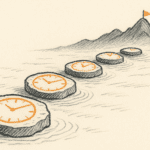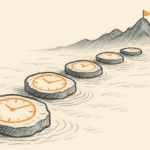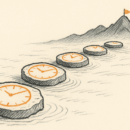Do your strategy discussions ever lead to anything tangible?
“ALL ABSTRACT STRATEGY DISCUSSIONS ARE USELESS
Strategy is worth thinking about if it causes you to make difficult or non-intuitive decisions. And so you have to test your commitment. “Are you saying that we have to cancel this product line?” is the sort of reaction your strategy statements ought to generate.
If you can’t put an example on the table, a concrete manifestation of the action being discussed, then you’re just prattling on, you’re not actually serious about strategy.”
SETH GODIN www.sethgodin.typepad.com (1 February 2011)
Strategy, by its very nature, tends to be a little up in the air. We are urged to discuss big issues, look at the big picture, map out overall direction, ‘helicopter out’ of the details – and we can be forgiven for talking in broad themes and abstractions.
This plays itself out in most strategy discussions held in Naivasha or Mt Kenya. The assembled worthies will discuss missions and values, competencies and capabilities, sustainable competitive advantage, must-win battles, and the like.
But it’s not enough.
Seth Godin, in a recent blog post, is putting his finger on an issue that dogs all strategists. As a practitioner myself, I recognize that this is indeed a paradox: strategy is about the big things; but it is only meaningful if it sweats the details. So where do we draw the line?
The first thing is to recognise the key point: that strategy is meaningless on its own. No matter how deep the intellectual discussion; how innovative the market positioning; how unique the competitive advantage – it’s all pointless unless it leads to something tangible, something measurable. Strategy is only useful in terms of the actions it guides you towards. Strategy is only successful if it causes real results on the ground and delivers actual performance improvement.
Otherwise it’s pie in the sky, just clever people debating abstractions in pleasant settings.
As Godin recommends, don’t confine your strategizing to themes and ideas. Force yourself to turn it into choices, products, people, tasks, deadlines, responsibilities, rules. Then the ethereal will take shape and the ephemeral will have a lasting impact.
Here’s an example. Many companies today will tell you that one of their distinctive capabilities is innovation: the capacity to introduce fresh, game-changing products or solutions. Sounds good, and very necessary in today’s fast-moving times. Except that it’s usually all concept and no substance. A single innovative product does not make you an innovator. Having a couple of bright things bubbling with ideas in your organization does not make you innovative.
Innovation as a competitive advantage refers to your continuous capacity to conceptualize, test and bring to market a series of unique products or services. It’s an ongoing thing, not a one-off. So if you are going to label it a key competitive advantage, you have to move quickly from words to facts. What’s your process for coming up with ideas? Who does it? How often? Is it a special event or is it hard-wired into your daily routines? How are ideas tested? How are they developed? How are they filtered? How are they taken to market? What’s your target for fresh new products? How do you judge success or failure? What organizational structures support this process? How is innovation rewarded? Which are your next three products, and by when will they reach customers?
That set of questions turns the concept of innovation into an ongoing reality. And those are the questions that most strategy discussions shirk (“big picture only”). Actually, the actualization of strategy is the proof that it matters and is worth doing, so take Godin’s advice and don’t avoid or delegate the details.
Before you conclude any strategy dialogue, you must have asked yourself: so what will this mean on Monday, in the office? Who’s doing this, and what have we just committed to doing?

Buy Sunny Bindra's new book
The X in CX
here »
Popular Posts
- Where are you rushing to—your funeral?June 29, 2025
- How to spot a real thinkerJune 15, 2025
- The map will appear—once you start walking.July 6, 2025
- Built the app, forgot the flowJune 22, 2025
- The pause that saves usJune 8, 2025















